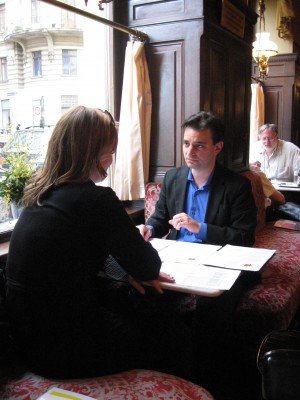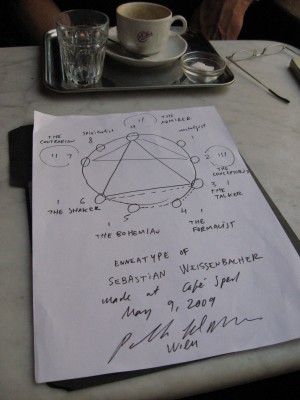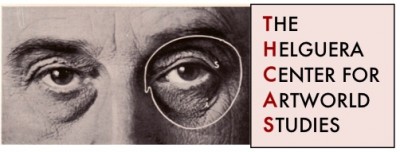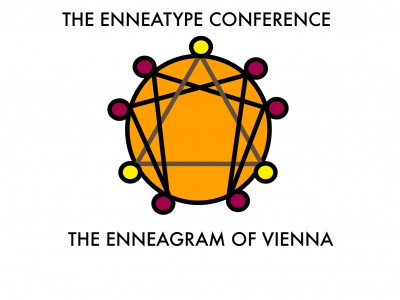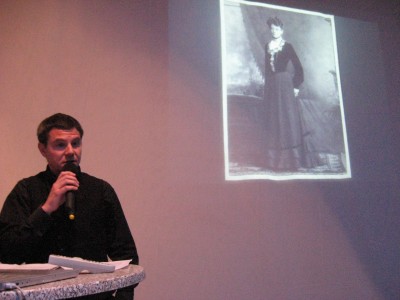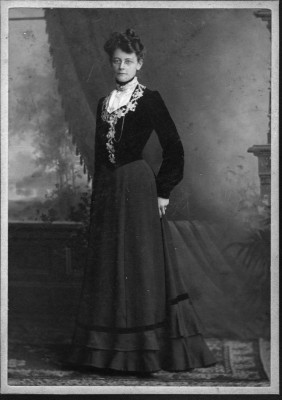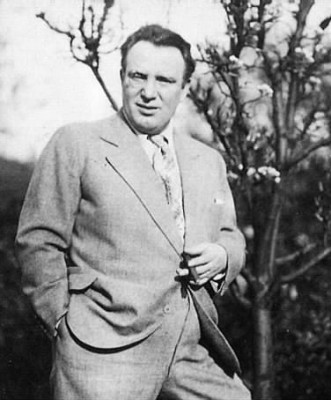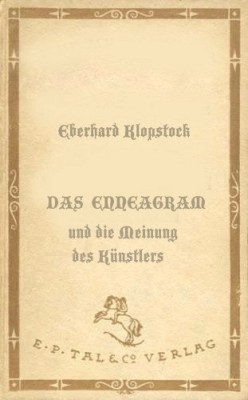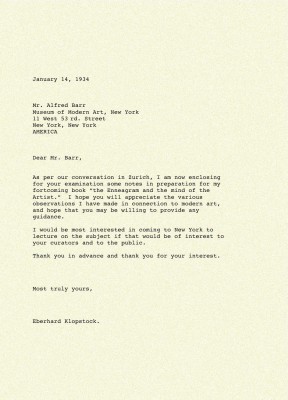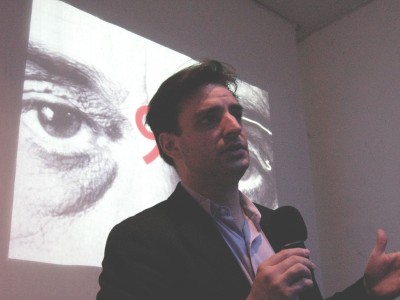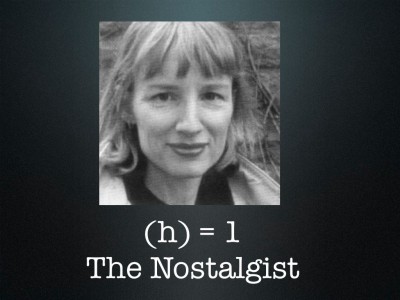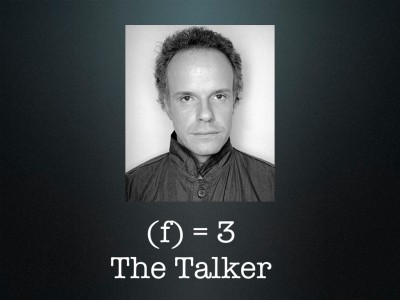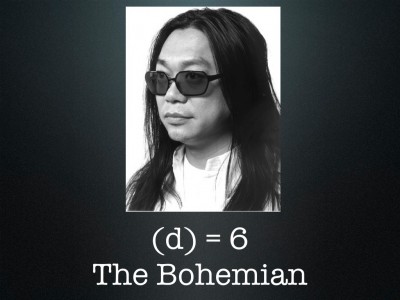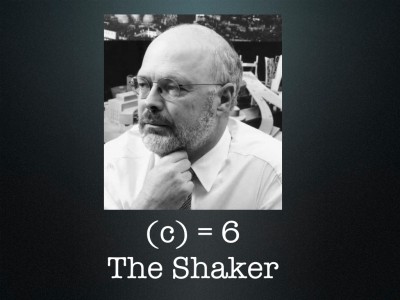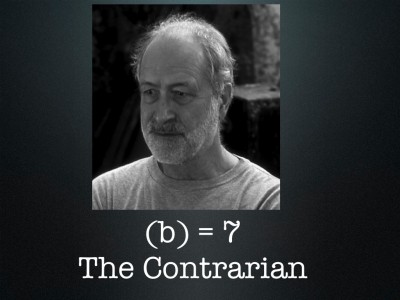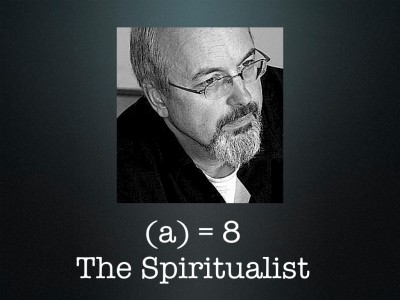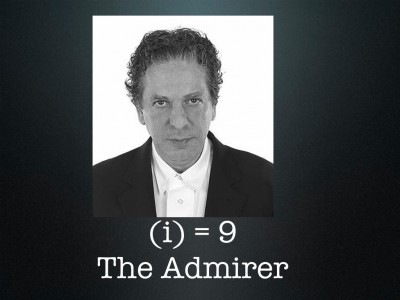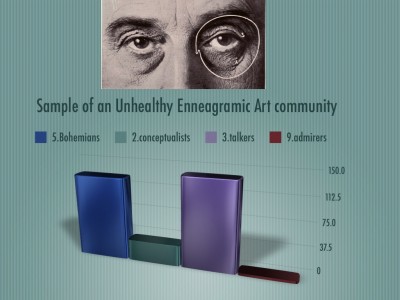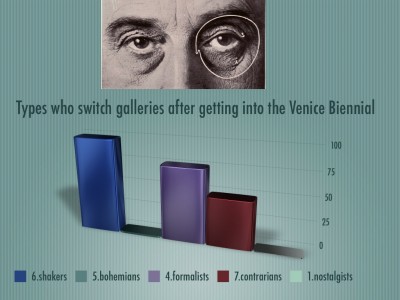The Enneatype Conference (Script) (2009)
THE ENNEATYPE CONFERENCE
The Enneatype Conference was a performance presented on May 9, 2009, at Lisa Ruyter’s studio in Vienna, Austria, per invitation of Parabol Magazine and curators Jasper Sharp and Elsy Lahner. The days of May 8th and May 9th I spent the time in Café Sperl, conducting “art personality assessment tests” using a system of my own making although inspired in the Enneagram Personality theory. Participants would respond to a questionnaire about their personal relationship to art, after which I would provide a diagnosis of their artistic personality type using enneagram categories.
While the enneagram test in fact turned out very accurate assessments of each individual’s attitude towards art, I wanted to stress the fallibility of any system that claims to provide “answers” about an individual’s personal situation. Thus the system, which at first was presented to all participants as an authentic scientific method developed in Vienna, was later unveiled as a complete fabrication.
The culminating event of the project was the performance, in the form of an academic lecture, that explained the various componens of the Art Personality Enneagram. What follows is the abbreviated text from that presentation.
Characters:
Rupert Steiner
Pablo Helguera
Steiner
Ladies and Gentlemen,
Welcome to the closing event of The Enneatype Conference, a unique occasion to celebrate the launch of The Enneagram of Vienna and celebrate the new issue of Parabol Magazine. My name is Rupert Steiner and I am the director of the Psychological Association of Art Therapists here in Vienna. Our mission is to study the ways in which art can reveal the potentiality of the individual. And, as such, it is an immense honor to me to present to you the work of Pablo Helguera, a Mexican artist and educator whose work has centered for many years on the very subject of the artistic personality. Helguera is the director of the Helguera Center for Artworld Studies, which has as its mission to understand the sociology of art and to propose the emergence of a new field of study, which he has described as artworld studies, using elements from social anthropology, biometrics, personology, economics, culinary theory, and of course psychology.
First we should explain what is an enneagram. The Enneagram is a nine-pointed figure inscribed in a circle. The meaning of the symbol itself, together with the personality types organized around the nine points, shows a system of knowledge about nine distinct but interrelated personality types, or nine ways of seeing and experiencing the world. The Enneagram of Personality is generally presented as a psychospiritual system for mapping and understanding nine possible personality types. Each personality type associated with the Enneagram represents a map of traits that highlights patterns of thinking, feeling, and behaving.
The notion of the artistic personality enneagram emerges from the work of Dr. Ingrid Lipsky. Dr. Lipsky was a student of Theodor Meynert at the psychiatric clinic of the university of Vienna, alongside with Sigmund Freud and other eminent psychiatrists and neuropathologists. She was also involved in hypnotism and spirituality, which led her to research the enneagram.
Dr Lipsky died at age 52 in 1910, in a safari accident in Africa, just before she got to publish her research. It was shortly after that one of her students, Eberhard Klopstock, who inherited her research papers, took her theories and attempted to develop them.
He tragically burned her original works in order to claim them as his own, then publishing a book in 1935 inspired on her ideas, titled “The Enneagram and the Artist’s Mind”.
Unfortunately, the book did not do well, and it was never reprinted. There are no known surviving copies.
It was thanks to Pablo Helguera, who while doing research in the museum of Modern Art in New York, found a letter from Klopstock to the then director, Alfred Barr, mentioning his research on this subject. Helguera has researched this information to update the original ideas of Ingrid Lipsky and thus bring the Enneagram of Vienna back to life.
He is here to tell us about the various categories of the Enneagram and share with us a system that studies and analyses the artistic personality of the contemporary art world. Please help me in welcoming Pablo Helguera.
[PH arrives onstage]
Pablo, we are enormously grateful to have you amongst us tonight.
PH
Thank you, so am I. I am delighted that we can share the knowledge of the enneagram tonight.
Steiner
Can you please tell us how you developed the enneagram?
PH
Well, I had to work from very initial information that was left from the notes of notable enneagramists, including Dr. Lipsky, as well as other psychologists and psychiatrists that have focused on the typology of the artist, not excluding Carl Jung and Hermann Rorscharch, who was very much interested in art as revealing issues of consciousness.
Steiner
So what is the difference between the personality enneagram and the artistic enneagram?
PH
The personality enneagram is something that was developed by many new age psychologists to explain the kinds of personalities in the world. The artistic enneagram focuses on figuring out specifically the kind of artistic sensibility that one has, and it is a very helpful way to understand one’s own relationship with art, your potential, and also to address your shortcomings as an arts professional. I believe that once you go through the process of learning your enneatype you will be able to become a much more successful individual in the art world.
Steiner
And I understand that you will now do a demonstration?
PH
Indeed. I now illustrate the way in which the enneagram works.
First I will conduct an act of group hypnotism which is desired to attain collective attention to a given subject, particularly when one is giving a boring lecture.
You all will look at my hand, moving like a pendulum. You all will fall in a state of deep sleep and peace, of full attention of everything I will say from now on.
Good, we are ready to go now.
I first would like you to consider a question, and choose the answer that most accurately reflect your way of feeling about art. After you have made your choices, you should remember the letter and we shall find out what each of your art personality types are.
When you see an artwork at a contemporary art gallery, list the impulse that is most likely to come to you first:
a) Thinking about how this artwork makes you feel
b) Asking to yourself what is right or wrong with this artwork
c) Trying to evaluate the artwork as good or bad
d) Wanting to know who the artist is
e) Wanting to know how this artwork was made
f) Wanting to know the back story of that art work
g) Wanting to know what the idea behind the work is
h) Remembering other pieces similar to that one
i) Non thinking, simply experiencing the work.
When you see a contemporary artist or arts professional of your same age and background receive a certain recognition that you could technically be in the same position to receive, your most likely reaction is:
a) Happiness for this person
b) Envy, wondering why you did not receive such recognition yourself
c) Thinking on what kind of friendships and professional contacts you need to make in the future to receive that same recognition yourself
d) Indifference
e) Thinking of what kind of work you need to make to receive such recognition in the future
f) Wanting to know the reasons for such recognition
g) Figuring out an innovative way to attain similar attention
h) Depression
i) Simple admiration for this person
Following you will hear about the different kinds of art personality types. If you chose, for instance, “h”,
you are
TYPE 1: THE NOSTALGIST
Nostalgists are in touch with their feelings, are sensitive, and highly perceptive of their environment. The nostalgist is inquisitive and likes to attain a lot of knowledge about an artwork. They can become very erudite and knowledgeable about a subject.
On average, they tend to emphasize too much the notion of biography, the context in which something was made, they draw lots of historical connections.
When they are unhealthy they can be depressive, self-destructive, obsessed with being up to date with the latest news of the art world, overromanticize everything, they can become delusive.
Examples: Many famous art historians are nostalgists. Janet Cardiff (on the photo), Matthew Buckingham, Mark Dion, Janet Cardiff, Sophie Calle, Christian Boltanski, Yinka Shonibare
if you chose “g” you are,
TYPE 2: THE CONCEPTUALIST
As its name indicates, conceptualists are abstract thinkers, capable of powerful synthesis, focused, and able to quickly grasp and advance the art discourse.
On average, they overemphasize theory, cause and effect, and argumentation in a work. They cannot fully enjoy a work unless they have clarified in their mind the main issues that the work addresses.
Bad conceptualists become out of touch with their feelings and have a difficulty sharing their emotions, are introverted, are desensitized toward art which arises emotions, can become aggressive and pretentious.
Examples: Joseph Kosuth, Allan Kaprow, Jacques Rancière, Daniel Birnbaum, Rosalind Krauss, Luis Camnitzer, Roberta Smith, Richard Serra, John Baldessari, Lawrence Weiner, Martin Creed
TYPE 3: THE TALKER
At their best, Talkers are able to translate the visual into words, becoming eloquent and able to put things in perspective. Gregarious and friendly, talkers have an ability to bring people together and become important spokespersons for large interest groups and gain access to important positions in the art world. Many performers and architects are talkers.
On average, Talkers can come off as superficial, saying a lot but without great substance, emphasizing hyperbole and syntax instead of content, can draw exaggerated relationships, and feel that they always have to say something even if it is unnecessary.
When they are unhealthy, they have a burning desire to protagonize everywhere, taking other ideas as one’s own, gossip too much, exaggerate reality to the point of becoming a storyteller, becoming a bit of a clown.
Examples: Hans Ulrich Obrist, Jerry Saltz, Marina Abramovic, William Kentridge, Robert Hughes, Maurizio Cattelan, Kirk Varnedoe
(e) is
TYPE 4: THE FORMALIST
Formalists are highly visual people, design-oriented, perfection-driven, with a great appreciation for craftsmanship and neatness. Organized, they are punctual, keep their word, and generally maintain a good balance of art and life.
On average, Formalists can be anal retentive, extremely demanding to others and to themselves, to the point of paralysis, it can take them time to make decisions and have anxiety in unresolved situations; they have no tolerance for ambiguity.
When they are unhealthy, they can be manipulative, easily irritated, dismissive of anything which may not be clear-cut, conservative, and materialistic.
Examples: Rachel Whiteread, Sol Lewitt, Donald Judd, Hannah Darboven, Michael Snow, Walead Beshty, John Cage, Gabriel Orozco
TYPE 5: THE BOHEMIAN
Bohemians are those capable to enjoy the art experience to its fullest degree; they are relaxed, open individuals who are highly receptive to other’s art and ideas and are contagious in their pleasure and enthusiasm, sharing their innovative thinking. They are friendly and accessible and can be very inspiring.
On average, They are abstract thinkers who can sometimes get too ambiguous and contradictory in their actions; they may lack personal drive to do things; can take them a long time to do a project, can be noncommittal.
However, if they are unhealthy, they Can be lazy, or falsely modest, boring, inattentive to detail and poor executors of projects.
Examples: Rirkit Tiravanija, Basquiat, Pippilotti Rist, Vito Acconci, Helio Oiticica, and others.
TYPE 6: THE SHAKER
Now, Shakers are very perceptive of social contexts and can influence social structures to their advantage. They are brilliant, highly diplomatic, alert, shrewd, and reliable. They excel in organizing and administration, as well as in making interesting connections and bringing people together. They can orchestrate large projects and usually are good with money. Many museum directors are shakers.
On average, Shakers can be social climbers and careerists; they can put the carriage before their horse and do things entirely out of self-interest. They can be a powerful ally and supporter but can also be a dangerous enemy.
At their worst, they can be Egotistical, with a problem with authority, extremely proud and manipulative, delusional and self-aggrandizing.
Examples: Thomas Krens, Olafur Eliasson, Christo, Jeffrey Deitch, Larry Gagosian, Okwui Enwenzor, Francesco Bonami, Mary Boone
TYPE 7: THE CONTRARIAN
Contrarians are the ones who usually open a debate. They have an innate ability to detect and question the status quo, and activating spaces of discussion and experience for others. They have sharp minds with complex perspectives and inspiring thoughts.
Generally, contrarians can be dogmatic, self-centered, and have a difficulty to relate to others who don’t share their views. Narcissistic, they are well-grounded, independent, and strong, although they resent not being given their due credit and always act as if they have a chip on their shoulder.
When unhealthy, beware: they can be extremely aggressive, dismissive of others, overly negative, insensitive to others, power-hungry, and snob.
Examples: Hans Haacke, Andrea Fraser, Martin Kippenberger, Terence Koh, Jens Hoffmann, The Guerrilla Girls, Barbara Kruger, Richard Prince, Donald Kuspit.
TYPE 8: THE SPIRITUALIST
Spiritualists are self-fulfilled people who can extract the best of every art experience and bring it to a higher realm. They are people in peace with themselves, who think with clarity and lucidity, and for whom art is a vehicle to attain illumination.
Spiritualists usually see beyond what the normal viewer seees, thus can be treated as delusional (and may actually be); can be sentimental and new-agey. They can act as shamans or evangelists.
If they are unhealthy, however, they can be naïve, delusional in believing that they are the new Buddha, condescending, passive-aggressive, resentful and insecure.
Examples: Bill Viola, Agnes Martin, Barnett Newman, Dan Flavin, Joseph Beuys, Eva Hesse, James Turrell
TYPE 9: THE ADMIRER
Admirers are centered individuals who can look at art in a balanced way and appreciate its strengths and weaknesses without falling prey to their emotions. At their best they are intelligent, self-effacing, extremely reliable as supporters, collaborators or allies.
Admirers can be calculating, materialistic, acquisitive, constantly amusing themselves with new things and experiences. They have a need to be loved.
When unhealthy, they are Impulsive and infantile in what they want. Can become offensive and abusive. They act on impulses rather than dealing with their own anxieties or depressions, so they can end up spent and despondent.
Examples: Charles Saatchi, Peter Norton, the Rubells
To finalize, I will show a few graphs that exemplify demographic research of the artworld using enneagramatic types.
Here is a sample of an unhealthy enneagramic art community, with an excess of Bohemians and talkers, and yet few admirers (which translates on scant collecting) and too few conceptualists.
In this other sample, one can appreciate the behavioral trends amongst art types who are inclined to switch galleries after being selected into the Venice Biennial. Shakers and Formalists are more likely to switch galleries given their acute sense of opportunity and order, respectively; contrarians will switch only because they like to switch, nostalgists are too attached to the past, and bohemians are not able to switch because they don’t have galleries in the first place.
so as you can see, there is a lot to be learned from this system, which can be mastered with enough study and analysis.
Any questions?
Steiner
Pablo, I do have a few comments.
PH
Go ahead.
Steiner
I have been listening to your presentation, and I am realizing that none of these statements have any scientific basis. Looks like you made them up.
PH
I think you are confused.
Steiner
I am starting to suspect that you fooled me and that actually Dr. Lipsky never existed. If you look closely at that photo of Dr. Lipsky that you gave me to show for the presentation, that looks like an old photo that you found in a thrift shop. And the guy that you showed in that picture is not Eberhard Klopstock. He looked too familiar to me. He actually is the singer Richard Tauber.
PH
You are wrong, Rupert.
Steiner
I think that your whole theory is bullshit. It is like all that new age philosophy that gives you a false sense of worth, that gives you false hopes, making you believe that there are powerful spiritual forces that will make you succeed. But the truth is that when we try to hard to search for that success we loose the sense of who we are and what we believe in. You have played with our feelings. Shame on you.
PH
I am sorry you feel this way. OK, something has gone wrong here. Maybe it is time to end this demonstration.
You may remember that you all are under hypnotic trance. So when I snap my fingers, you will not remember any of this conversation. The Enneagram of Vienna will completely vanish from your memory, the same way it came, it will vanish from everyone’s memory the same way it was gone before— it will never have existed. We will not think of who we are but only go about our lives, and our art, withholding judgment. We will simply try to survive, and be at times tortured and at times happy, not entirely sure why, and let our identities, and our relationship with art, remain a mystery, where it belongs.
[making another hypnotic gesture]
Nine, Eight, seven, six, four, three… two… one… welcome back. And thank you.
[they exit]
Tags: Absurd, Education, Fiction, Institutes, Language, Lecturing, Perception, Performance, Psychology of Art, Sociology, Tests, Theater, Vienna
